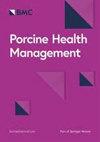Foot lesions and forelimb skin abrasions in suckling piglets: development and risk factors
IF 3
2区 农林科学
Q1 VETERINARY SCIENCES
引用次数: 0
Abstract
Foot lesions in suckling piglets have been associated with poor flooring in several studies and were recently proposed to be indicative of swine inflammatory and necrosis syndrome. However, identical findings are also the typical outcome of various non-infectious causes; thus, further risk analysis is needed. The objective of this study was to describe the development of heel bruising, coronary band lesions and forelimb skin abrasion in suckling pigs up to 5 days of age. Furthermore, the effects of various intrinsic and extrinsic factors were examined. On each of four commercial piglet-producing farms, piglets from two or three batches of eight sows were studied. The piglets were included within 18 h after birth. Each piglet was individually scored four times. The score for the heels differentiated six (0–5) and for the coronary band and forelimb skin abrasion three stages (0–2). The body weight was measured two times. The effect of the floor was estimated by allocating the sows randomly to farrowing pens equipped with either soft rubber mats covered with litter or fully slatted plastic floors. The final analysis comprised data from 1045 piglets. Foot lesions were not found at birth but started to develop on day 1. On day 5, heel bruising was found in 94%, main claw coronary band lesions in 49% and forelimb skin abrasion in 73% of the piglets. In a multifactorial logistic regression analysis, it was shown that a slatted plastic floor significantly increased the odds of heel bruising and coronary band lesions, while a rubber floor with litter increased the odds of forelimb skin abrasions. Foot and forelimb lesions in new-born piglets are mainly induced by the floor. The effect of slatted plastic floors on heel bruising showed an overwhelming OR of 52.89 (CI 26.29–106.43). Notably, coronary band lesions in young suckling piglets occur on slatted as well as non-slatted floors, indicating that the piglets incur these injuries not only from the wedging of their feet into the gaps between slats but also from contact with the floor while suckling. Based on these findings, preventive measures should be redirected to the improvement of the floor in the farrowing pen, particularly in the area under the sow’s udder.哺乳仔猪的足部损伤和前肢皮肤擦伤:发展和风险因素
在多项研究中,哺乳仔猪的足部病变与仔猪生长不良有关,最近有人提出这可能是猪炎症和坏死综合症的征兆。然而,相同的结果也是各种非感染性原因的典型结果;因此,需要进行进一步的风险分析。本研究的目的是描述 5 日龄以下乳猪脚跟淤血、冠状带损伤和前肢皮肤擦伤的发展过程。此外,还研究了各种内在和外在因素的影响。在四个商业仔猪生产猪场中,每个猪场都对来自两批或三批八头母猪的仔猪进行了研究。仔猪在出生后 18 小时内出生。对每头仔猪分别进行了四次评分。脚跟的评分分为六级(0-5),冠状带和前肢皮肤擦伤分为三级(0-2)。体重测量两次。通过将母猪随机分配到铺有软橡胶垫或全板条塑料地板的产仔栏,对地板的影响进行了估计。最终分析包括 1045 头仔猪的数据。仔猪出生时未发现蹄部病变,但在出生后第 1 天开始出现。第 5 天,94% 的仔猪发现脚跟瘀伤,49% 的仔猪发现主爪冠状带病变,73% 的仔猪发现前肢皮肤擦伤。多因素逻辑回归分析表明,板条塑料地板会显著增加脚跟擦伤和冠状带病变的几率,而带垫料的橡胶地板会增加前肢皮肤擦伤的几率。新生仔猪的足部和前肢损伤主要是由地板引起的。板条塑料地板对足跟擦伤的影响显示出压倒性的 OR 值 52.89(CI 26.29-106.43)。值得注意的是,幼龄哺乳仔猪的冠状带损伤既发生在有板条的地板上,也发生在无板条的地板上,这表明仔猪受到这些损伤不仅是因为脚被楔入板条间的缝隙,还因为哺乳时与地板的接触。基于这些发现,预防措施应转向改善产仔栏的地板,尤其是母猪乳房下的区域。
本文章由计算机程序翻译,如有差异,请以英文原文为准。
求助全文
约1分钟内获得全文
求助全文
来源期刊

Porcine Health Management
Veterinary-Food Animals
CiteScore
5.40
自引率
5.90%
发文量
49
审稿时长
14 weeks
期刊介绍:
Porcine Health Management (PHM) is an open access peer-reviewed journal that aims to publish relevant, novel and revised information regarding all aspects of swine health medicine and production.
 求助内容:
求助内容: 应助结果提醒方式:
应助结果提醒方式:


